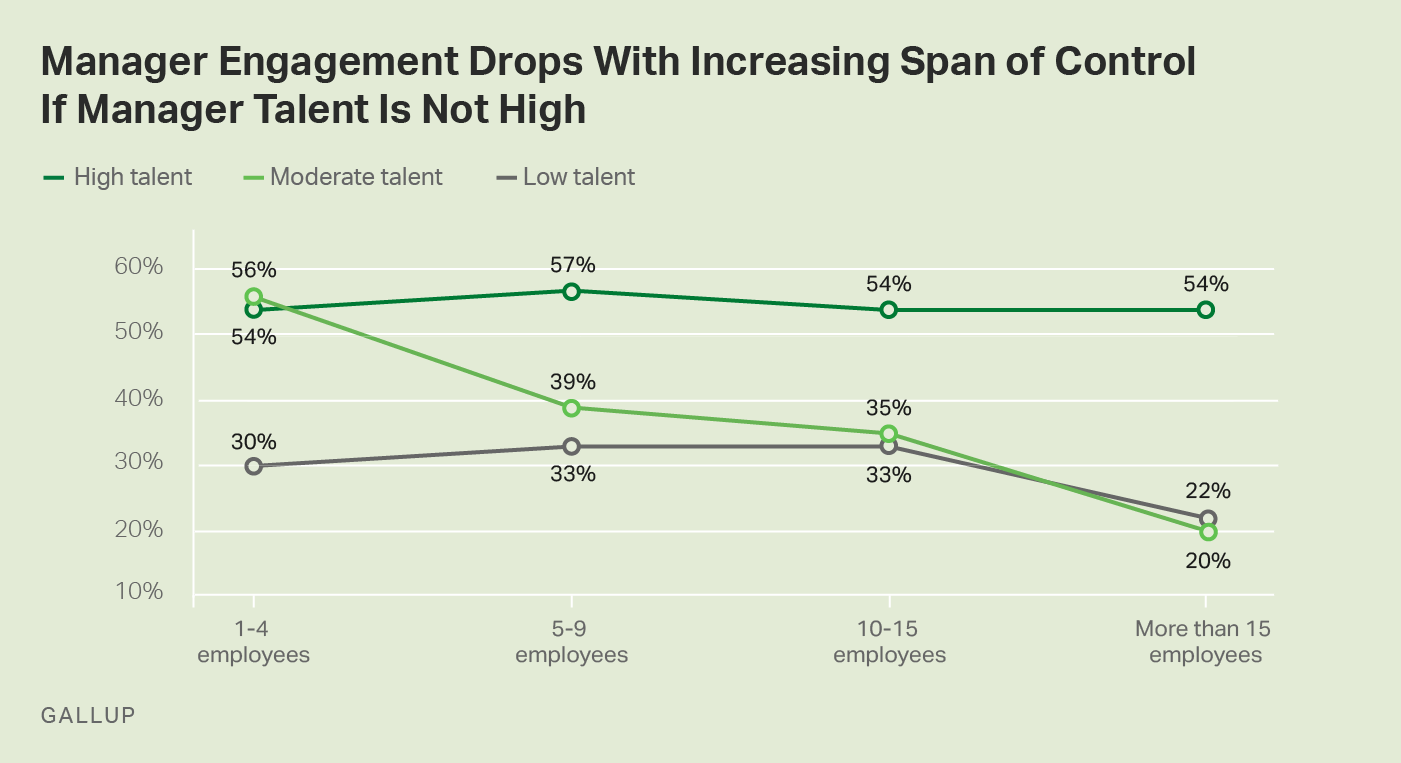Story Highlights
- Manager quality influences engagement more than team size does
- Successful managers have five traits in common
- Measuring talent helps leaders put the right person in the manager role
Managing people has always been very difficult -- employees don't come with an operating manual. Each person is different and has their own unique set of quirks and complexities.
Significant changes in the workplace make managing today's employees even more difficult. Daunting challenges now include increases in remote working, matrixed teams, digitization, automation, blending of work and life, and building diverse and inclusive environments. And let's not forget changes in what employees expect of their workplace -- they want ongoing coaching and development, not simply to follow the boss's orders and have work delegated to them.
Adding more people to a team makes things that much more difficult. In fact, Gallup is often asked: What is the ideal number of people a manager should manage? Is there a sweet spot?
One way to answer this question is to study the engagement of employees on teams of various sizes.
Gallup has studied the engagement levels of 3 million teams. The number of employees on these teams varies considerably. On average, teams with fewer than 10 members have the highest and the lowest levels of engagement. Essentially, teams with fewer members can more easily be swayed in one direction or the other. Managers seem to have more opportunity for influence, good or bad, in these small teams.
While team size -- and other team dynamics -- can influence engagement, the most important factor is the quality of the manager or team leader.
How Engaged Are Your Managers?
The engagement of the manager -- their own experience as an employee -- is foundational to quality managing. Three in 10 managers globally are engaged -- feel involved and enthusiastic -- in their jobs. Gallup’s meta-analysis of more than 200,000 manager-led teams found that more highly engaged managers have more engaged teams.
The problem is that there's a cascade of engagement from the manager to the employee. It is essential that managers are engaged -- when they are engaged and developing, they are more likely to engage and develop their employees, cooperate with managers on other teams, and encourage their team to cooperate with other teams. And the reverse is true when they're disengaged. The ability to accomplish any important initiative in an organization has a lot to do with whether managers collaborate effectively with other managers and their teams.
The engagement of managers is also related to the number of people on the manager's team. As the number of team members increases, the manager's engagement decreases.
But there is an important nuance -- the decline in engagement with increasing team size is not the same for all managers. Some managers maintain high engagement with increases in team size.
So, what is the common denominator for these managers who are highly engaged regardless of their team's size?
Five Traits of Engaged Managers
One important factor is the manager's innate tendencies for managing other people -- their natural talent for getting exceptional work done through others. While we can all improve our effectiveness in working with others, some instinctively look forward to the interpersonal complexities while others dread them. For the latter, managing people is an ongoing struggle. The more people you give them to manage, the worse they do.
While team size -- and other team dynamics -- can influence engagement, the most important factor is the quality of the manager or team leader.
Gallup has found the following innate tendencies in managers who are highly successful in coaching others to high engagement and performance. Managers with an abundance of these traits are also more likely to be engaged in their work:
- Motivation: Inspiring teams to get exceptional work done
- Workstyle: Setting goals and arranging resources for the team to excel
- Initiation: Influencing others to act; pushing through adversity and resistance
- Collaboration: Building committed teams with deep bonds
- Thought process: Taking an analytical approach to strategy and decision-making
Gallup's team of workplace scientists recently conducted a large-scale study of the manager experience in the workplace. As part of this investigation, we measured the innate management tendencies listed above among 3,579 managers. We also measured their level of engagement and the number of people they directly manage.
Managers with low levels of these five innate tendencies tend to have lower engagement regardless of the number of people they manage.
On average, approximately one-third of managers are engaged in their work and workplace. For those with high levels of the five traits listed above, the percentage engaged is 20 percentage points (57%) higher and maintains this high level regardless of the number of employees a manager has: four or fewer, five to nine, 10 to 15, or more than 15.
Those with moderate levels of these five innate tendencies have equally high engagement when they have four or fewer people on their team, but their engagement declines as team size increases.
Managers with low levels of these five tendencies tend to have lower engagement regardless of the number of people they manage. The job of managing is less enjoyable for them, and their lack of engagement is likely to rub off on their team and others in the organization.

So, the optimum span of control for a manager depends, in part, on how the manager is naturally wired. Does inspiring others, setting goals and arranging resources, pushing through resistance, building committed teams, and analytical decision-making come naturally? If so, then the manager can take on more team members and do so without becoming disengaged or burning out. If not, it's best to limit the number of direct reports they manage and provide them with some effective tools or shortcuts to make managing less of a burden.
How to Choose the Most Effective Managers
You can assess and predict hardwired tendencies using scientific instruments before selecting another manager -- something few organizations do. To significantly improve the odds that someone will be successful in a managerial role, evaluate them on the five traits listed above (motivation, workstyle, initiation, collaboration and thought process).
The optimum span of control for a manager depends, in part, on how the manager is naturally wired.
Unfortunately, the current practice of management promotes employees for the wrong reasons. When Gallup asked thousands of managers how they became managers, the top two reasons they gave were: success in a prior nonmanagement role and tenure.
On the surface, these reasons seem sensible. Those who are high performers or who have been with the company for a long time are rewarded with a higher-status position. And promotion to management comes with an increase in pay and status, which intensifies the desire to become a manager.
Gallup analytics finds that most current team leaders do not have the natural tendencies for managing people. When that is the case, they struggle in their role, and this makes them miserable -- which is particularly discouraging because many were inspired in their previous role as an individual achiever.
The good news is that most organizations have the management talent they need inside their companies, and the right assessment system can find it.
So how can you build a system and culture that most effectively identifies the right people to become managers in your organization?
- Use a scientifically designed and validated instrument to assess management prospects on the five traits of great managers: motivation, workstyle, initiation, collaboration and thought process.
- Give talented individual contributors opportunities to lead projects and teams. Give them a shot. Watch them in action, and take note of who can lead winning teams.
- Don't base your next manager decision solely on tenure or success in a nonmanagerial job. Becoming a manager shouldn't be an automatic rite of passage.
- Make it desirable for highly successful individual contributors to continue to excel and gain status in their role. Look closely at the economic value of your most successful individual contributors. Your best should be able to make more income than many of your managers because of their value.
In the end, knowing the innate talents of each manager answers many of an organization's most pressing questions -- not least, what is the ideal number of employees for that person to lead?
Make engaged management part of your workplace strategy:
- Hire for talent, not tenure.
- Get insights into the science of management.
- Give managers the development they need.






